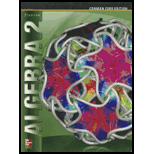
Concept explainers
(a)
Number of each drink sold using Cramer’s rule.
(a)
Answer to Problem 55PPS
Vendor sold 650 small drinks, 325 medium drinks, and 410 large drinks.
Explanation of Solution
Given information:
Small drinks sold for $1.15 each.
Medium drink sold for $1.75 each.
Large drink sold for $2.25 each.
Total sales for 1385 drinks were $2,238.75.
Calculation:
Let
Number of medium drinks be x .
Then
Number of small drinks be 2x .
And
Number of large drinks bey .
Now,
Translate the word problem into equation.
For number of drinks:
That becomes
For price of drinks:
That becomes
Now,
To find the determinant for the given matrix, use Cramer’s rule.
For x :
For y :
Substitute the values:
For x :
For y :
Write the diagonal of each element:
For x :
For y :
Then Simplify:
For x :
For y :
Therefore,
Vendor sold 650 small drinks, 325 medium drinks and 410 large drinks.
(b)
Vendor’s sales for the second week.
(b)
Answer to Problem 55PPS
Vendor’s sale for the second week is $2,426.
Explanation of Solution
Given information:
For the second week,
Small drink sold for $1.25 each instead of $1.15 each.
Vendor sold 140 fewer small drinks, 125 more medium drinks, 35 more large drinks.
Calculation:
We have
Small drink sold for $1.25 each instead of $1.15 each.
In second week,
Vendor sold 140 fewer small drinks.
That means
He sold 510 small drinks for $1.25 each.
Thus,
He sold small drinks for $637.50.
Vendor sold 125 more medium drinks.
That means
He sold 450 medium drinks for $1.75 each.
Thus,
He sold medium drinks for $787.50.
Vendor sold 35 more large drinks.
That means
He sold 445 large drinks for $2.25 each.
Thus,
He sold medium drinks for $1001.25.
To calculate the sale of second week, sum up the sale of all above three categories:
Therefore,
Vendor’s sale for the second week is $2,426.
(c)
Whether raising the price of the small drink was a good business move.
(c)
Answer to Problem 55PPS
Yes, raising the price of the small drink was a good business move as it brought a nice profit.
Explanation of Solution
Given information:
From Part (a),
Total sales for 1385 drinks were $2,238.75.
From Part (b),
Total sales for 1405 drinks were $2,426.
By increasing the price of the small drinks,
The sale of small drinks went down.
Whereas,
The sale of medium or large drinks went up.
Since the difference between the price of drinks diminished,
Some of the customers preferred to pay a little extra to get a bigger quantity of drink.
Therefore,
The raise of price was a good business move as it brought a nice profit.
Chapter 3 Solutions
Glencoe Algebra 2 Student Edition C2014
Additional Math Textbook Solutions
Calculus: Early Transcendentals (2nd Edition)
University Calculus: Early Transcendentals (4th Edition)
A First Course in Probability (10th Edition)
College Algebra with Modeling & Visualization (5th Edition)
Elementary Statistics: Picturing the World (7th Edition)
- A research study in the year 2009 found that there were 2760 coyotes in a given region. The coyote population declined at a rate of 5.8% each year. How many fewer coyotes were there in 2024 than in 2015? Explain in at least one sentence how you solved the problem. Show your work. Round your answer to the nearest whole number.arrow_forwardAnswer the following questions related to the following matrix A = 3 ³).arrow_forwardExplain the following termsarrow_forward
- Solve questions by Course Name (Ordinary Differential Equations II 2)arrow_forwardplease Solve questions by Course Name( Ordinary Differential Equations II 2)arrow_forwardInThe Northern Lights are bright flashes of colored light between 50 and 200 miles above Earth. Suppose a flash occurs 150 miles above Earth. What is the measure of arc BD, the portion of Earth from which the flash is visible? (Earth’s radius is approximately 4000 miles.)arrow_forward
- e). n! (n - 1)!arrow_forwardSuppose you flip a fair two-sided coin four times and record the result. a). List the sample space of this experiment. That is, list all possible outcomes that could occur when flipping a fair two-sided coin four total times. Assume the two sides of the coin are Heads (H) and Tails (T).arrow_forwarde). n! (n - 1)!arrow_forward
 Algebra and Trigonometry (6th Edition)AlgebraISBN:9780134463216Author:Robert F. BlitzerPublisher:PEARSON
Algebra and Trigonometry (6th Edition)AlgebraISBN:9780134463216Author:Robert F. BlitzerPublisher:PEARSON Contemporary Abstract AlgebraAlgebraISBN:9781305657960Author:Joseph GallianPublisher:Cengage Learning
Contemporary Abstract AlgebraAlgebraISBN:9781305657960Author:Joseph GallianPublisher:Cengage Learning Linear Algebra: A Modern IntroductionAlgebraISBN:9781285463247Author:David PoolePublisher:Cengage Learning
Linear Algebra: A Modern IntroductionAlgebraISBN:9781285463247Author:David PoolePublisher:Cengage Learning Algebra And Trigonometry (11th Edition)AlgebraISBN:9780135163078Author:Michael SullivanPublisher:PEARSON
Algebra And Trigonometry (11th Edition)AlgebraISBN:9780135163078Author:Michael SullivanPublisher:PEARSON Introduction to Linear Algebra, Fifth EditionAlgebraISBN:9780980232776Author:Gilbert StrangPublisher:Wellesley-Cambridge Press
Introduction to Linear Algebra, Fifth EditionAlgebraISBN:9780980232776Author:Gilbert StrangPublisher:Wellesley-Cambridge Press College Algebra (Collegiate Math)AlgebraISBN:9780077836344Author:Julie Miller, Donna GerkenPublisher:McGraw-Hill Education
College Algebra (Collegiate Math)AlgebraISBN:9780077836344Author:Julie Miller, Donna GerkenPublisher:McGraw-Hill Education





